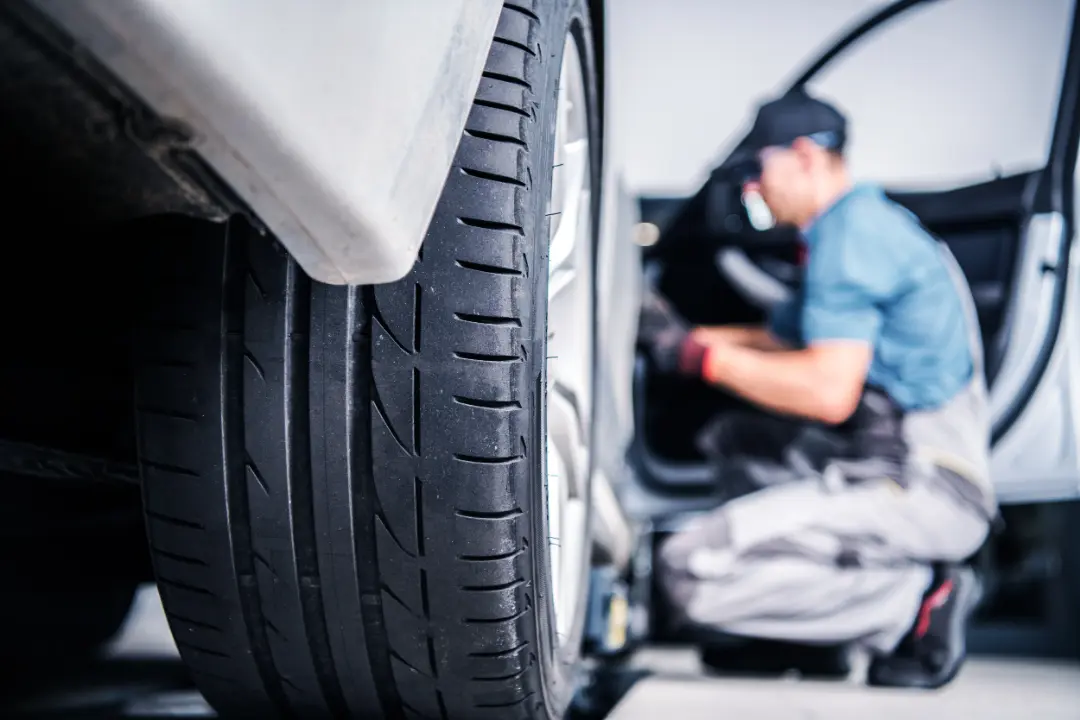Do you need to switch between PSI, bar, and kPa for your tyre pressures? Our intuitive tyre pressure measurement converter is here to help. Get ready to adjust your tyre pressure accurately with easy, accurate conversions, clearly explained here.
Key Takeaways
- Tyre pressure is crucial for optimal vehicle performance and safety. Depending on the region and industry standards, tyre pressure is measured in PSI, bar, or kPa; roughly, 1 bar equals about 14.50 PSI.
- A user-friendly tyre pressure measurement converter converts PSI, bar, and kPa easily, supporting regular vehicle maintenance and correct air pressure adjustments.
- Proper tyre pressure varies with vehicle load and driving conditions, and regular checks are essential for safety, performance, and fuel efficiency; professional, free tyre inspections are available at service centres.
Understanding Tyre Pressure Units: PSI, Bar, and kPa
Tyre pressure, or tyre air pressure, is a fundamental aspect of vehicle maintenance, playing a pivotal role in ensuring optimal traction, handling, and braking while driving, thus boosting vehicle safety and reducing fuel consumption. But how do we measure tyre pressure? The primary quantification methods include pounds per square inch (PSI), barometric pressure (bar), or kilopascal (kPa). These units fulfil the same purpose, but various regions and industries utilise them differently. For instance, 1 BAR pressure equals approximately 14.50 PSI, providing a practical conversion reference. It’s worth noting that atmospheric pressure can also affect tyre pressure readings, making it essential to consider when maintaining your vehicle.
Seamless Tyre Pressure Conversion: Use Our Tool
Navigating these different tyre pressure units, including the metric unit, can seem challenging. To simplify this, we present an effortless tyre pressure calculator that immediately translates tyre pressure measurements between PSI, bar, and kPs. This user-friendly tool allows quick conversions by inputting any unit’s current tyre pressure value—PSI, bar, or kPa.
Now, let’s delve deeper into how these conversions work.

How to Convert PSI to Bar
Converting PSI to Bar is easy, and similarly, converting bar to psi is just as simple. Simply divide the PSI value by 14.504. This simple calculation will instantly give you the equivalent Bar value, eliminating the need for complex conversions.
Translating Bar to kPa
What about switching from Bar to kPa? It’s just as straightforward! Multiply the pressure value in the Bar by 100.
Using this established factor, the tool for converting tyre pressure measurements accurately converts from Bar to kPa.
Switching kPa to PSI
Lastly, you have two options for converting kPa to PSI. Either multiply the kPa value by 0.14504 or divide it by 6.895. Both methods will yield the PSI value accurately, enabling you to maintain the correct air pressure levels for your vehicle tyres.
The Right Pressure for Every Journey
Maintaining the proper car tyre pressure isn’t a one-size-fits-all affair. It requires adjustments according to vehicle load and driving conditions. Your vehicle’s handbook is a treasure trove of precise figures for normal conditions and when the vehicle is burdened with extra weight, ensuring you maintain the correct tyre pressures.
Consistent checking of tyre pressures is critical, requiring that tyres on the same axle have matching pressure levels. However, this pressure can vary between the front and rear axles to accommodate vehicle dynamics. Regular maintenance of tyre pressures is vital because the air pressure within the tyres supports the vehicle’s entire weight, contributing significantly to performance and safety.
Maintaining Optimal Tyre Health with Regular Checks
As you regularly check your vehicle’s oil and water levels, tyre pressure checks should be a routine part of your vehicle maintenance. Regular checks are crucial for vehicle performance as tyre pressure can decrease by one to two PSI each month, affecting fuel efficiency.
Nationwide automotive service centres such as Kwik Fit offer free tyre inspections without any obligation, which can serve as a resource for drivers to ensure optimal tyre condition. These professional tyre checks include thoroughly examining the entire tyre, which can reveal whether tyre pressures are at their recommended levels.
Expert Insights on Tyre Pressure Gauges
When it comes to tyre pressure gauges, you have plenty of options. From pencil and dial gauges that are reliable in any condition, given their battery-free operation, to digital gauges offering convenience features such as backlit screens and self-calibration, your preferences and needs are well-catered for.
All Vehicle Services, a Michelin-accredited centre, provides expert tyre and auto care services, including assisting customers in choosing the appropriate tyre pressure gauge. With such a diverse assortment of tyre pressure gauges, you’ll likely find one that suits your needs, budget, and convenience.
Adjusting Pressure for Front and Rear Tyres
Different vehicles may require different air pressure levels in front and rear tyres due to variations in weight distribution, vehicle design, and load-carrying requirements. For instance, front tyres generally carry a higher pressure than rear tyres to counterbalance the additional weight of the engine and transmission, especially in front-wheel-drive vehicles.
In contrast, some rear-wheel-drive cars may require lower pressures in the front tyres to improve tyre wear, given the reduced weight on the front end. Electric vehicles typically require higher tyre pressures to accommodate the increased weight of their large batteries.

Discover Your Vehicle’s Recommended Tyre Pressure
Your vehicle’s recommended tyre pressure is not a number picked out of thin air; it’s a carefully calculated figure that ensures optimal vehicle performance and safety. You can find this specific information in:
- Your vehicle’s handbook
- On the sill of the driver’s side door
- Inside the fuel cap
- On the dashboard of modern cars.
While adhering to these recommendations is crucial, adjusting your tyre pressures under various loading conditions or changing the tyre brand or type from the original equipment is also essential. Regular checks and adjustments ensure you drive with the optimal tyre pressure.
How Tyre Pressure Affects Fuel Efficiency and Tread Wear
Tyre pressure affects driving safety, fuel efficiency, and tyre tread wear. Under-inflated tyres can cause excessive contact with the road, increasing friction and leading to more significant wear. Moreover, not appropriately inflated tyres can make the engine work harder due to increased rolling resistance and fuel consumption.
Overinflated tyres, on the other hand, lead to a rougher ride, compromised handling, and uneven tread wear. Correctly inflated tyres reduce rolling resistance, which improves fuel efficiency and enhances safety while prolonging tyre life. Whether underinflated or overinflated, both scenarios present risks to your vehicle’s performance, safety, and your wallet.
When to Add More Air: Understanding Valve Caps and Pressure Levels
Understanding when and how much air to add to your tyres is crucial. You should check tyre pressure when the tyres are cold to ensure accurate readings, ideally before driving or at least three hours after parking the vehicle. For a precise check, a tyre gauge is advisable, as a tyre can have low air pressure without appearing flat.
Vehicles equipped with a Tyre Pressure Monitoring System (TPMS) can alert the driver when they detect low tyre pressure, typically below 25% of the recommended level. Regular monitoring helps in the early detection of slow punctures, which can otherwise go unnoticed for a long time.

All Vehicle Services: Your Partner in Safe Driving
At All Vehicle Services, we are committed to your vehicle’s health and safety. With over 50 years of combined expertise, our team of highly experienced technicians provides a wide array of automotive maintenance and repair solutions, including:
- Tyre services
- Brake services
- Engine diagnostics
- Oil changes
- Suspension repairs
- Battery replacements
We aim to keep your vehicle running smoothly and safely at all times.
Summary
Understanding and maintaining the correct tyre pressure is not just a matter of routine vehicle maintenance; it’s a critical factor in ensuring your safety on the road, optimising fuel efficiency, and prolonging the lifespan of your tyres. With our comprehensive guide and user-friendly tyre pressure conversion tool, you can now navigate the world of tyre pressure with ease and confidence.
Frequently Asked Questions
What are the different units used to measure tyre pressure?
The different units used to measure tyre pressure are pounds per square inch (PSI), barometric pressure (bar), and kilopascal (kPa). These are the standard measurements used for checking tyre pressure.
How often should I check my tyre pressure?
Always check your tyre pressure every two to four weeks before starting a long journey to ensure your safety and optimal vehicle performance.
How does tyre pressure affect fuel efficiency?
Improperly inflated tyres can increase rolling resistance, causing the engine to work harder and leading to higher fuel consumption.
What is the consequence of overinflated tyres?
Overinflated tyres can lead to a rougher ride, compromised handling, and uneven tread wear, which can affect your vehicle’s performance and safety.
How can I find my vehicle’s recommended tyre pressure?
You can find your vehicle’s recommended tyre pressure in the vehicle’s handbook, on the sill of the driver’s side door, inside the fuel cap, or on the dashboard of modern cars. Always refer to these sources for accurate tyre pressure information.


